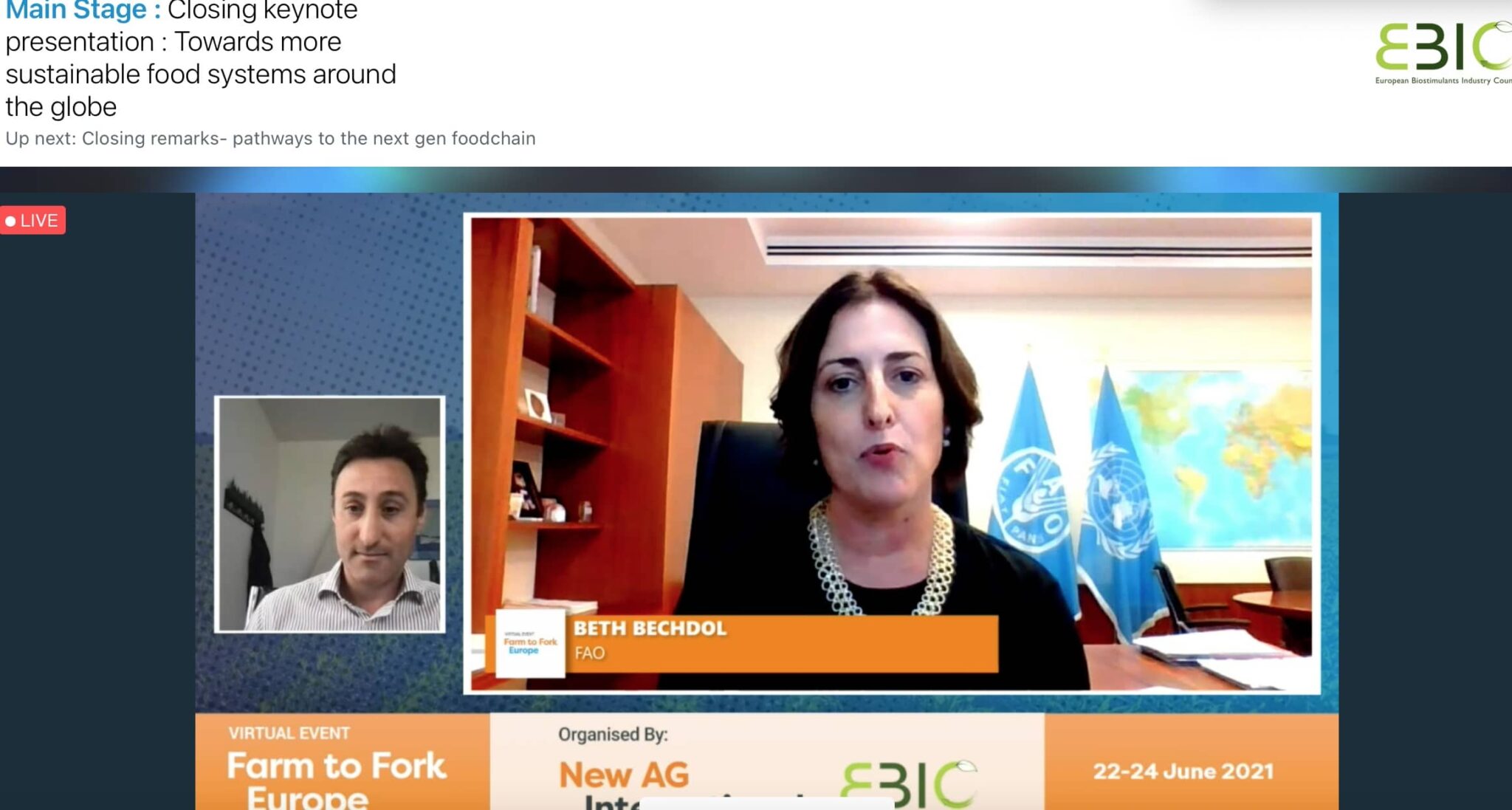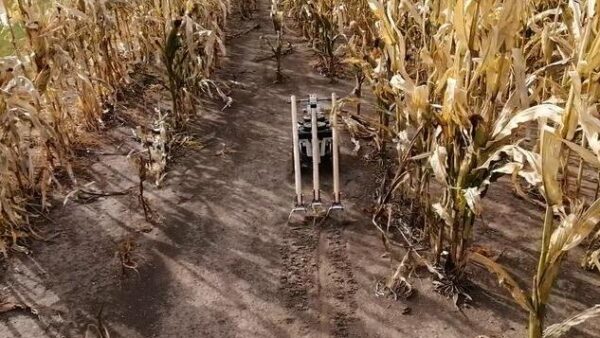The European Farm to Fork Strategy is calling for a reduction by 50 per cent of the use and risk of chemical pesticides, a reduction of nutrient losses by at least 50 per cent and a reduction in the use of fertilisers by at least 20 per cent by 2030. In addition, it aims to reach 25 per cent of agricultural land under organic farming. And whereas most people are convinced that genetic improvements and better varieties will be key to achieving these goals, fewer people are aware that biostimulants will also have a major role to play.
Most market analysts report that the European biostimulants market accounts for roughly half of the global market. Estimates of the value of the European market range around USD $1.5-2 billion in 2022 and estimate the sector is growing at 10-12 per cent per year, despite most countries not yet having adapted their regulatory frameworks to consider biostimulants. The biostimulant industry re-invests a substantial share of turnover into R&D (3-10 per cent). To find out more about what biostimulants are, and which role they can play in EU agriculture, European Seed sat down with Kristen Sukalac of the European Biostimulants Industry Council (EBIC) to get her take on these products.
European Seed (ES): Kristen, can you describe in a nutshell what the EBIC is and explain it bit more about its activities?
Kristen Sukalac (KS): EBIC’s mission is to ensure plant biostimulant technologies are valued as integral to sustainable agriculture while securing an enabling regulatory framework for all of them. As the representative organization for the biostimulant industry in Europe with more than 60 active full members – ranging from dozens of SMEs to multinationals – EBIC embodies the voice of the biostimulant industry in Europe. Any company placing plant biostimulants on the Europe market is eligible to join EBIC.
We just celebrated EBIC’s 10th anniversary in mid-June. Much of the first decade was dedicated to securing access to the European single market for plant biostimulants. While we will continue working on regulatory questions, our emphasis is increasing on promoting the role of biostimulants in sustainable agriculture and helping stakeholders throughout the food chain to understand the benefits they provide. In this context, we are particularly happy to do this interview and would be happy to cover specific topics seed producers might have in the future.

R&D-based plant biostimulants in more sustainable food systems.
ES: The word ‘biostimulant’ seems to encompass quite a few different products. How does EBIC define ‘biostimulant’?
KS: Scientists note that plant biostimulants are defined by what they do, not by what they are made of. They consist of a wide variety of substances (hydrolysed proteins, humic and fulvic acids, plant and seaweed extracts, some inorganic compounds, etc.) and microorganisms that improve plant nutrition and soil fertility. A growing share of products are complex formulations that include a combination of substances and/or microorganisms. Plant biostimulants enhance natural processes that increase nutrient use efficiency (including helping plants access nutrients in the soil and fixing nitrogen), improve plant tolerance to abiotic stresses like extreme temperatures and drought, and improve harvest quality. They are defined by the function they provide.
ES: What are the main advantages of using biostimulants?
KS: It depends on the biostimulant product. Overall, plant biostimulants help plants use available resources more efficiently and help them better cope with difficult growing conditions such as extreme temperatures, drought, water logging, etc. Both benefits can improve yields. Many biostimulants often improve quality traits such as sugar content or tolerance of handling.
ES: Does each biostimulant work the same in each crop, or are there crop specificities?
KS: It depends on the biostimulant and what it is intended to do. Microbial plant biostimulants often have an indirect effect on plants by improving the microflora in the soil. The performance of such products will often depend more on soil conditions than on the plants in question. Biostimulants that provide general benefits like promoting early root growth work on groups of crops. The effects of biostimulants that improve quality will show more variability because the quality criteria are not the same; for example, you want peas to have lots of sugar and less starch but the opposite for potatoes.
ES: In due time, could biostimulants replace fertilizers and/or crop protection products?
KS: No. Biostimulants are complements to fertilizers and crop protection products. Because many plant biostimulants improve nutrient uptake and use, they could reduce the amount of fertilizers applied, but not the amount of crop nutrients that plants need. So, the reductions would relate more to nutrients that are currently lost to the environment. By promoting general plant vigour and growth, plant biostimulants could reduce the need for plant protection interventions, just as balanced nutrition with fertilizers does, but plant biostimulants do not provide plant protection functions. What biostimulants are really doing is turning a two-legged stool into a three-legged stool, which will be steadier.
[tweetshare tweet=”Tolerance to difficult growing conditions is a key function of many biostimulants.” username=”eyJtZDUiOnRydWV9″]
ES: A lot of emphasis these days is on making sure crops can cope with a changing climate. Can biostimulants help with that?
KS: Tolerance to difficult growing conditions is a key function of many biostimulants. There are various mechanisms through which they provide such benefits. Where plant biostimulants promote root growth, they increase water uptake and thus make it easier for plants to withstand dry conditions. Other biostimulants help plants better tolerant very high or very low temperatures or help farmers time flowering and fruit setting relative to expected frosts.
ES: Instead of using biostimulants, could a farmer achieve the same results with a combination of fertilizers and crop protection products?
KS: Plant biostimulants are being introduced to address leaky holes in agricultural production and fill a different function from fertilizers and crop protection products. Plant biostimulants help optimize natural processes in plants and in the root zone that relate to nutrition and stress responses. Fertilizers provide a specific set of mineral nutrients, and plant protection products target pests and diseases.
ES: Biostimulants were initially mainly used in the organic sector. Have they become mainstream now?
KS: Yes, plant biostimulants are widely used in many different crops, including arable crops. On the other hand, we are concerned that changes in the European regulation on organic production might actually make it more difficult to use plant biostimulants for organic production, which seems counterproductive. This is because biostimulant products are evolving quickly because of R&D, and the positive-list approach of the organic regulation does not cope well with innovation. Already, we’ve seen that many of the substances that used in plant biostimulants have been totally overlooked in the new annex of fertilising products allowed for organic production.
ES: In which situations would you advise a farmer to use biostimulants?
KS: It depends on the farmer’s specific situation, so a crop advisor is better placed to answer that question. As a general answer, though, we’d say that if farmers have high-performing integrated nutrition plans and want to try to further improve the efficiency of their production and to make the crops more robust in the face of volatile growing conditions, it’s worth looking at plant biostimulants. They offer a way to increase yields and return per hectare for a modest investment. In short, plant biostimulants are compatible with a lot of consumer demands for how their food is grown, so plant biostimulants generally help farmers address growing sustainability demands while still increasing yields and return per hectare.
Plant biostimulants need to be integrated thoughtfully into farming practices, which is why EBIC, and its members cultivate relationships with farmers, advisors, and other input sectors, as well as the downstream food chain.
European Seed readers might be interested to know that several biostimulants – especially those that promote early root growth – can be applied as a seed coating. The European Commission recently clarified that where the Fertilising Products Regulation says that plant biostimulants can be applied at any growth stage, that includes seeds.
ES: Why should Europe invest in biostimulants?
KS: Plant biostimulants are general non-hazardous, cost-effective, and give farmers an important new tool to help them farm profitably under increasingly volatile conditions. They can play an important role in helping to meet policy objectives like reducing fertilizer applications through greater efficiency (Farm to Fork Strategy) and helping achieve climate-smart agriculture. They also play a role in maintaining and even restoring or improving soil health. When biostimulants promote root growth and the root mass is left in the ground, that increases the soil carbon content. Microbial biostimulants improve soil micro-biodiversity. Healthy soil provides several ecosystem services including protecting against erosion, retaining water and nutrients, and carbon sequestration.
Biostimulants also contribute to the circular economy. For example, the animal by-products and some of the plant materials used to make hydrolysed proteins are secondary raw materials from other value chains. Microalgae need carbon dioxide to grow, and one of EBIC’s members sources its CO2 from a neighbouring energy plant. Lignosulfonates are a by-product of paper manufacturing. Chitin is sourced from seafood and insect shells. These are just a few examples of how the biostimulants sector contributes to circularity and waste reduction.
Last, but not least, many of the companies active in the sector are small and medium enterprises, and many of those companies are based in smaller towns where they add welcome jobs for highly skilled workers, boosting local economies in areas that don’t always have many other industries.
ES: Are you facing any challenges in the EU, e.g., with regards to the regulatory environment?
KS: Any innovation will face challenges with the regulatory framework because regulation always lags behind innovation. The 2019 Fertilising Products Regulation was a huge step forward because it legally recognized plant biostimulants for the first time at the European level. However, there are details that are still being worked out concerning some component materials and how to get them cleared for use in fertilising products. For example, the list of animal by-products is currently empty with no visibility on when it will be populated and what the candidate materials are. Similarly, the list of four microorganisms that are allowed in EU fertilising products is only a small fraction of what is already on the market under national rules, let alone relative to what is in the R&D pipeline, and there is currently no process for extending the list.
One of the ongoing challenges we have is the persistent confusion between potential effects of ingredients and the actual function of a specific product when used according to the manufacturer’s instructions. For some reason, although it is well accepted that substances like copper can be either a fertilizer or a fungicide depending on the use, there is a lot of hesitancy to accept this same principle for several biostimulant components, despite clear scientific evidence of the products’ biostimulant functions.
[tweetshare tweet=”One of the challenges is the confusion between potential effects of ingredients and the actual function of a specific product when used according to the manufacturer’s instructions.” username=”eyJtZDUiOnRydWV9″]
Finally, since this regulation takes a completely different approach than previous agricultural product regulations, producers need to understand how to complete the conformity assessment process, and some bugs need to be worked out.
ES: How are you working together with other agri-food sectors?
KS: Working with the whole food chain is central to EBIC’s Mid-Term Strategy. We believe that we have to engage with both what we call “farm” (upstream) and “fork” (downstream) stakeholders. To this end, we just launched our new “Farm to Fork Europe” conference in partnership with New Ag International 22-24 June 2021.
The three days of the conference covered investment for next-gen food production, agri-food innovations (both technology and business models) and consumer-facing issues. Our speakers ranged from the Deputy Director General of the UN Food and Agriculture Organization and a policy officer in the European Commission’s Farm to Fork Strategy Unit to farmers. We also had several speakers working on digital agriculture and robots as well as food producers. We also made sure that the next generation was heard by including speakers from the European Young Farmers and Thought for Food.
This year’s edition was virtual, but we hope that the first in-person edition of the conference will be held in Athens in 2022. We would love to have more participants from the seed sector there next year since our aim is to deliver an event that provides value across the food chain and promotes collaboration and joined-up thinking.
As well as the EBIC website, you can follow us on Twitter or LinkedIn to receive more information, and you can sign up for the mailing list on the conference website: https://informaconnect.com/farm-to-fork/. You can get a free taste of the conference by viewing the past digital roundtables archived on the site. In April of this year (2021), EBIC hosted a debate among DG AGRI, the European Young Farmers and on the biostimulants industry on “Eco-schemes & CAP Reform: Making the European Green Deal Real.” In October 2020, EBIC’s president Luca Bonini (CEO of Hello Nature) had a one-on-one conversation with the Head of the European Commission’s Farm to Fork Strategy Unit on “Fostering resilient, sustainable and dynamic agriculture and food production in Europe: the roles of innovation and policy.”
Where on the web: Find out more about biostimulants on www.biostimulants.eu
Want to read more? Check these out:
https://european-seed.com/2021/08/ebic-ecofi-fertilizers-europe-iva-issue-joint-statement-on-fertilizing-products-plant-biostimulants/
https://european-seed.com/2021/04/all-in-one-lifetime/
https://european-seed.com/2021/01/tackling-pests-in-rice/











